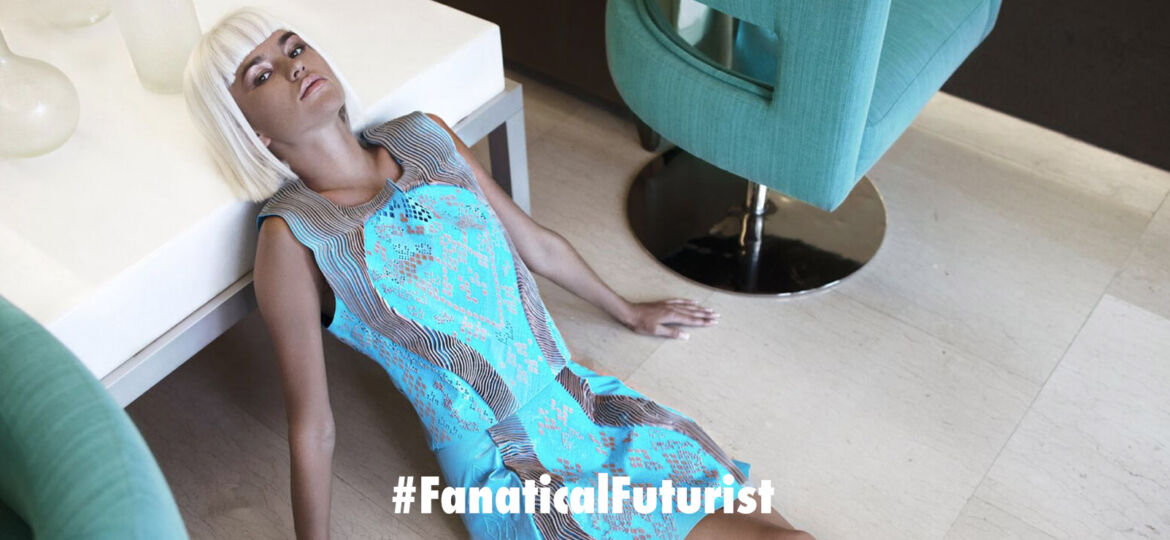
WHY THIS MATTERS IN BRIEF
3D printed clothes can be customised and printed on demand using sustainable new materials, giving fashion designers new options and reducing the industry’s environmental impact.
Downloadable 3D printed personalised sustainable fashion. I think you’ll agree it’s quite a catchy phrase – or at least that’s what many of today’s most innovative fashion designers, from London to Miami, think anyway. Julia Daviy is a Miami based designer and she’s one of these new breed fashionistas who’s tearing up the fashion rule book, pushing the boundaries, and helping change the world of fashion as we know it.
Earlier this month Daviy launched her own line of beautiful 3D printed garments named “The Liberation Collection” at New York Fashion Week where it was hailed as the “first full women apparel collection manufactured utilising only 3D printing technology.” And that’s a massive deal – true on demand fashion.
3D printed fashion is the future
Daviy’s innovative 3D printed wearable tech-infused collection signals a growing emphasis on producing garments in new ways using new materials that not only replace the old petrol-based textiles with sustainable textiles and leather alternatives, such as Modern Meadow’s 3D bioprinted leather which is real leather, just without the cow – something that caught the superyacht crowds eye when I presented to them recently – but that also helps reduce the fashion industry’s less than envious environmental footprint and record.
“I wasn’t that focused on the design of the collection but more obsessed with how to implement a more sustainable approach in the clothes I was about to create,” said Daviy at New York Fashion Week.
The garments were 3D printed using new Thermoplastic Polyurethane (TPU) materials and flexible resins that were mixed together into large format Fused Deposition Modeling (FDM) 3D printers based on Stereolithography (SLA) technology, that are commonly used to 3D print models, prototypes and patterns, and Daviy now hopes her work inspires others to produce garments in a less wasteful and more ethical way.
“There is a huge potential for the market of innovative, sustainable clothes, thanks to the wide range of technologies combining knowledge and expertise,” she added.
Daviy is also fascinated by the movement toward so called smart garments and apparel following the advent of smart sensors and wearables technology. In fact, this is was first attracted her to the 3D printing technology and its immense potential in the first place.
“Nowadays we can create clothes similar to leather, but with 3D printing technology embedded with smart sensors and this collection is the perfect example of that,” she said.
Daviy’s designs for her New York Fashion Week collection were inspired by coral and shells and other exoskeletons patterns found in the marine life, which – according to her was possible thanks to the limitless approaches the 3D printing manufacturing has to offer.
“3D printing allows the designer to control the thickness, shape, colour of the product. In fact, with 3D printing I can create any shape, on any type of pattern, from [almost] any kind of material,” she said.
One of the other advantages of course of this technology, which isn’t lost on the likes of Adidas, Nike and Under Armour, who are also using it to 3D print sneakers on demand in the backs of their stores now, is that it allows people to customise garments in a near infinite number of ways and not just mass produce them, but also let them do small batch runs – something that in the past would have been prohibitively expensive. As you can see from the video above the garments are gorgeous, and this is just the beginning of a trend that will one day take over the world – something that isn’t lost on Amazon as they too start zeroing in on the technology to create the world’s first fully autonomous fashion retailer… but that’s another story.
















